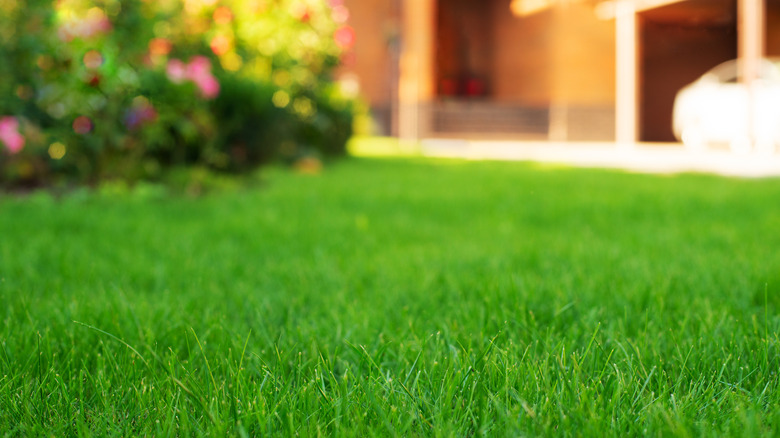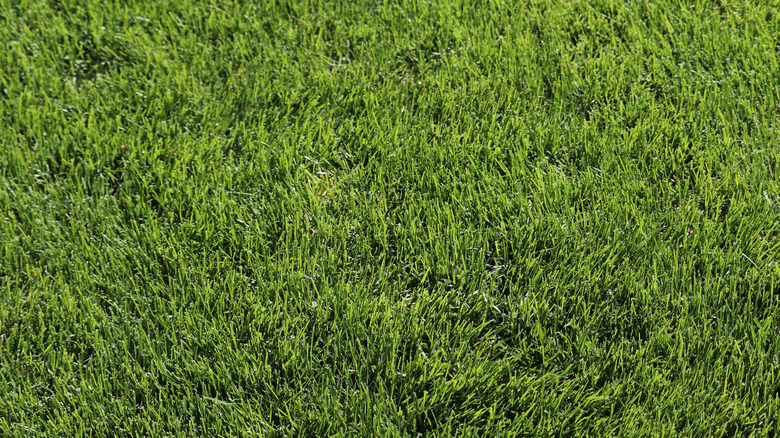How To Identify What Type Of Grass You Have (And Why It Matters)
All grass may look the same at a glance, but the reality is that lawn turf comes in several varieties. Whether you're looking after an existing lawn, or plan to seed a new one, being able to identify the grass type will equip you with some helpful knowledge. You'll know whether the grass type is suitable for your region, what to expect from its growth cycle, and how to care for it properly. Fortunately, it's not that hard to establish what type of grass you have.
A quick way to narrow down the grass variety on your lawn — or one that's perfect for it — is to consider your geographic location. Certain grass types thrive in the country's colder climate zones, while others grow in the warmer regions. So, if you live in Minnesota, chances are your lawn has (or needs) one of the cool-season grass varieties, such as Fine Fescue or Kentucky bluegrass. Conversely, a southern lawn is likely home to one of the warm-season grasses, like Bermudagrass or St. Augustine. The appearance of the turf can help you positively identify the grass type once you've narrowed down the varieties based on region. The color is a crucial characteristic to note, since different types come in different shades of green. Likewise, blade texture varies between grass types and offers a good way to pinpoint the variety on your lawn. Below, you'll learn how to tell apart common grass varieties and get them to flourish in your yard.
Common types of grass and their distinguishing features
Fescues, bluegrass, perennial ryegrass, and bentgrass are excellent cool-season grasses that commonly grow in the country's north. Fescues have a distinct, rich green color, and their blades are shiny. The two types of bluegrass — Kentucky bluegrass and rough bluegrass — stand out with their emerald, V-shaped blades. Perennial ryegrass has thin blades and a vibrant shade of green, but you won't mistake it for another type because this variety dies down quickly when the cold sets in. Finally, bentgrass also has thin leaves, along with a narrow, prolonged ligule at the joint between the blade and the sheath. It's unlikely that your lawn has bentgrass, nor is it a good option to consider — this variety is really tough to care for, and its use is largely limited to professionally maintained golf courses.
As a group, warm-season grasses stand out from their cold-season counterparts with their broader blades. Also, you'll notice that they all sprout in the year's warmest months, then die down during fall — the opposite of cool season types' lifecycle. That said, there are still differences between these heat-loving grasses. For example, Bermudagrass is easy to spot thanks to its surface-dwelling roots and fuzzy blades. Meanwhile, Zoysia has short, pale green blades whose wide appearance and dense growing pattern gives the turf a carpet-like aesthetic. Finally, St. Augustine grass has deep-green blades with recognizable blunt edges.
How to care for cool- and warm-season grasses
How you care for your lawn depends on whether you have cool- or warm-season grass. If your lawn features one of the cool-season varieties, the first thaw is a good time to rinse away deicing salt that may have gotten onto the turf. Come early spring, rake the lawn to eliminate dead organic matter, and start mowing when the first grass shoots emerge. This is a good time to kill weeds (without harming the lawn) and reseed balding areas. When warm weather arrives, mow, fertilize, and irrigate the lawns as normal. If you have Kentucky bluegrass, it will demand more fertilizer. You'll fertilize again before fall rolls around, then it will be time to overseed the lawn (no later than a month and a half before the first frost). For the rest of the year, mow and water until the grass no longer grows.
Winter is busier for warm-season lawns. Even if the grass is dormant, you can trim, weed, and rake it as needed. In the warmest regions, the grass should start sprouting around March, so mow the lawn, apply treatments based on soil tests, and look out for weeds. In the summer, fertilize the lawn, but let the grass grow taller to preserve ground moisture. Unless the grass has signs of fungus, or is too tall, leave the mowings on the lawn — this will reduce the fertilization needs. Continue mowing and fertilizing until the grass goes dormant for the year.


